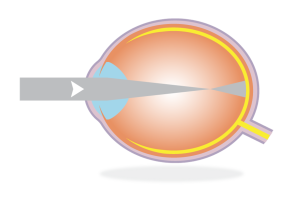by Treacy Adamo, OD, MS, FAAO

Managing the largest epidemic in eye care of recent history makes it a no brainer to choose myopia as a sub-specialty focus of a private practice. Here in the United States, the prevalence of myopia in teenagers is 56% to 59%.1 Some say that by reducing the rate of myopia progression by 50%, the prevalence of high myopia can be reduced by up to 90%.2 By decreasing the prevalence of high myopia, it would also decrease the risk for serious eye diseases such as retinal detachment, glaucoma, and myopic maculopathy.3
Both genetics and environmental exposures contribute to the risk of developing myopia4. During the COVID-19 pandemic quarantine, children and adults alike rarely left the house and were stuck on screens for seemingly unending hours. It can be postulated that myopia progression rates may even be faster than even originally thought over this past year. It’s a concern that is very top of mind to many parents.
In our practice, we use MiSight® 1 day* soft contact lenses as well as orthokeratology for myopia management. Other things in my armamentarium include atropine eye drops and bifocal spectacle lenses when appropriate. We feel education is a large part of the parent buy in to this myopia management program.
Over the past few weeks, I have been able to start eleven children in myopia management. A family with two siblings comes to mind. I have been seeing this family for a few years and I introduced our myopia management program at their last annual visit when I saw the start of their myopia. Knowing that both parents also suffer from myopia, I wanted to address the myopia at the lower levels they presented with last year (-1.50, OU, age 10 and -1.00, OU, age 8). At the time, the patients’ mother wanted to think about it. Upon return this year, both children progressed to -2.75 and -2.00 respectively – now the patients’ mother shared my concern. Thankfully both siblings were candidates for the Brilliant Futures™ Myopia Management Program with MiSight® 1 day. The sisters, both of Asian descent, and with both parents having myopia were almost destined to develop myopia and progress as often happens. Both are strong students and are dedicated to their studies. As most students in Illinois, both girls have participating in e-learning and have been using their computer screens far more than ever before. They also reported that they have not been getting out very much because there has not been much to do during the pandemic. Both participated in our application and removal training while I discussed more about myopia and the concern we have for continued progression. The lenses were easy for the girls to handle†
and both learned application and removal in quick fashion±5 – perhaps there was some sisterly peer pressure. Both reported good comfort with MiSight® and were excited to be glasses free 5. Their mother was happy to be addressing this eye health concern6. The “wow factor” and smiles on their faces never gets old. While I love caring for all my patients and anything they present with, these children frequently stand out as some of my favorite.
Some other children in the same time frame had already progressed past -6.00. Other options were utilized in these cases. In a self-reflection moment, I was reminded that repeated conversations with parents need to start earlier before they reach -6.00. I like to discuss myopia management with any parent of a child who has myopia or showing signs of reduced hyperopia less than +0.75 prior to age 6. Just as in any disease state, early intervention with education and clinical management pays dividends in the long run7. As more attention is brought to myopia as a disease state, I am seeing parents coming into their child’s exam more educated on this topic. My goal is to do my part to make sure a child stays below a -5.00, keeping them out of the “high myopia” category and more preferably, below -3.00, keeping their risks of complications to a minimum.
I am so grateful that I have a strong team surrounding me. I realize that the parents of these children with myopia or pre-myopia are already in my practice. From reaching out to my mentors and educating myself, I’ve become inspired to developing our myopia management program and rallying my team. When we all drive the same consistent, holistic message to these families, we get to be a part of this journey together for a lifetime of healthy vision.
I cannot overstate how valuable it is that the state of Illinois mandates a comprehensive eye exam prior to entering kindergarten. By having this opportunity to evaluate children early and start discussions around outdoor play, visual postures, and limiting screen time, I am hoping I can achieve my goal and do my part in keeping children below -3.00! The mission is large, but achievable with every optometrist taking myopia management seriously.
Treacy Adamo, OD, MS, FAAO is the practice owner of Hinsdale Advanced Eye Care providing full scope family eye care in Hinsdale, IL with sub-specialties in myopia management, vision therapy and concussion rehabilitation, dry eye management and preventative eye care.
†Children new to contact lens wear aged 8-12
± By 1 month. As reported by parents.
*Indications for use: MiSight® 1 day (omafilcon A) soft (hydrophilic) contact lenses for daily wear are indicated for the correction of myopic ametropia and for slowing the progression of myopia in children with non-diseased eyes, who at the initiation of treatment are 8-12 years of age and have a refraction of -0.75 to -4.00 diopters(spherical equivalent) with ≤ 0.75 diopters of astigmatism. The lens is to be discarded after each removal.
1. Theophanous C, Modjtahedi BS, Batech M, Marlin DS, Luong TQ, Fong DS. Myopia prevalence and risk factors in children. Clin Ophthalmol. 2018 Aug 29;12:1581-1587. doi: 10.2147/OPTH.S164641. PMID: 30214142; PMCID: PMC6120514.
2. Brennan NA. Predicted reduction in high myopia for various degrees of myopia control. Contact Lens & Anterior Eye. Volume 35, Supplement 1, E14-E15, December 01, 2012.
3. Flitcroft DI. The complex interactions of retinal, optical and environmental factors in myopia aetiology. Prog Retin Eye Res. 2012 Nov;31(6):622-60. doi: 10.1016/j.preteyeres.2012.06.004. Epub 2012 Jul 4. PMID: 22772022.
4. Xiong S, Sankaridurg P, Naduvilath T, Zang J, Zou H, Zhu J, Lv M, He X, Xu X. Time spent in outdoor activities in relation to myopia prevention and control: a meta-analysis and systematic review. Acta Ophthalmol. 2017 Sep;95(6):551-566. doi: 10.1111/aos.13403. Epub 2017 Mar 2. PMID: 28251836; PMCID: PMC5599950. Huang HM, Chang DS, Wu PC. The Association between Near Work Activities and Myopia in Children-A Systematic Review and Meta-Analysis. PLoS One. 2015 Oct 20;10(10):e0140419. doi: 10.1371/journal.pone.0140419. PMID: 26485393; PMCID: PMC4618477. Lanca C, Saw SM. The association between digital screen time and myopia: A systematic review. Ophthalmic Physiol Opt. 2020 Mar;40(2):216-229. doi: 10.1111/opo.12657. Epub 2020 Jan 13. PMID: 31943280.
5. Sulley A et al, Wearer experience and subjective responses with dual focus compared to spherical, single vision soft contact lenses in children during a 3-year clinical trial. AAO 2019 Poster Presentation.
6. CVI data on file 2019. Global survey by Decision Analyst with 1,009 parents in UK, Canada, Germany, Spain, Hong Kong, Australia/NZ.
7. Tideman JW et al. Association of axial length with risk of uncorrectable visual impairment for Europeans with myopia. JAMA Ophthalmol. 2016;134:1355-1363








